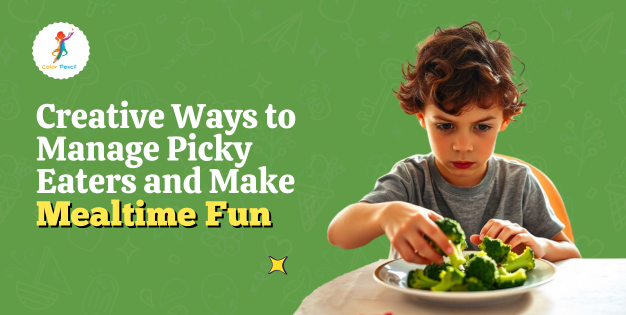
5 Ways to Teach Kids About the Origin of Easter
Curious about what’s the origin of Easter and how to make it meaningful for kids? You’re not alone. While Easter often brings images of chocolate

If you’ve ever spent half an hour making a meal, only for your child to declare, “I don’t like it” before they’ve even looked at their plate—welcome to the club. The picky eater phase is one of those parenting hurdles no one really warns you about. Suddenly, foods they loved last week are “yucky,” and you find yourself bribing them to take just one bite.
We get it: you’re tired of the battles, the bribes, and the endless “Just one bite!” negotiations. With some simple strategies and a little creativity, you can bring the fun back to food and help your picky eater explore new tastes without the drama.

For kids, food can be more appealing when it’s part of something fun. Think of ways to make meals interactive and engaging: let them “build” their dinner, add toppings, or arrange their plate in a playful way.
Try this:
Making food playful helps distract from the “I don’t want that” mindset and encourages exploration.

Introducing new foods doesn’t have to feel overwhelming for you or your child. Instead of serving a full portion of something unfamiliar, start small. A single bite or even just a nibble is enough to spark curiosity.
Pro Tip: Pair new foods with familiar ones. If your child loves pasta, mix in a few small pieces of zucchini or spinach. The comfort of their favorite dish can help them feel more open to trying something new.
This approach works well for picky eaters food because it builds familiarity and trust over time, expanding their preferences naturally.

Kids are more likely to eat what they’ve helped create. Turn meal prep into a shared activity by letting them play a role in choosing, preparing, or plating food.
While you’re focusing on mealtime, transitioning to new feeding tools, like a sippy cup, can also be part of the process. For guidance on when to make the switch, check out tips for introducing a sippy cup.
Age-appropriate tasks:
Cooking together also introduces picky eaters to healthy recipes in a way that feels fun and empowering, rather than like a lecture about “good for you” foods.

Having a picky eater’s meal plan can take the stress out of deciding what to make every night. The key is to include foods everyone loves while subtly incorporating variety.
Tips for planning meals:
For example, if they love chicken nuggets, serve them alongside roasted veggies one day and sweet potato fries the next.
Instead of focusing on what your child doesn’t eat, celebrate the small victories. Tried a new food? That’s a win. Ate all their carrots? Another win! Positive reinforcement builds confidence and helps them feel proud of their progress.
Pro Tip: Avoid pressuring your child to eat. Instead, create a relaxed environment where they feel comfortable exploring food at their own pace.
Patience and encouragement go a long way in helping kids develop a healthy relationship with food.
Fussy eating can be caused by sensory sensitivities, a fear of trying new things (neophobia), or developmental stages where kids assert control over their choices—including food!
Encourage the kids without pressure. Offer small portions, involve them in meal prep, or make food fun with creative presentations. Consistency and patience are key.
If picky eating is affecting your child’s growth, energy levels, or overall health, it’s a good idea to consult your pediatrician.
Most kids grow out of picky eating by the time they’re 5-7 years old. However, exposure to a variety of foods early on can help speed up the process.
Babies can become fussy with food due to teething, growth spurts, or changes in routine. Continue offering a variety of foods, and remember, these phases are temporary.
Mealtime with picky eaters doesn’t have to feel like a battle. With creative strategies like making food fun, starting small with new foods, and involving your child in the kitchen, you can turn their hesitation into curiosity. Pair these tips with a thoughtful meal plan, and watch as your little one begins to explore new flavors and enjoy the experience of eating.
Remember, patience and positivity are your best allies. With time, those “I don’t like it” moments will turn into “Can I have seconds?” Happy eating!
1 Comment